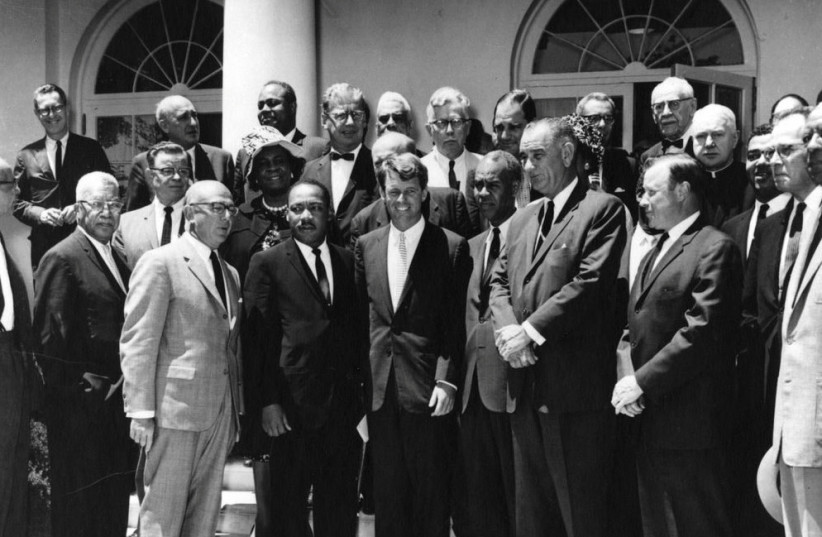Sybil Kaplan has just self-published an 82-page memoir of the time she was closely connected to the Hatzaad Harishon youth group between 1965 and 1969, first as their Israeli folk dance instructor and then as their youth leader.
What makes Hatzaad Harishon: A “First Step” Love Story remarkable, and her reminisces significant, is that Hatzaad Harishon’s membership was all black and Jewish. And Sybil, while Jewish, is, well, white.
I remember that period. One of those who were off-and-on affiliated with Hatzaad Harishon, Naomi F., became a member of Betar, the Zionist youth movement I was active in, and she even spent a year at the Mahon program in Israel. She later was a dance partner of mine and also taught at the Brotherhood Synagogue in Greenwich Village. Earlier, I had met Black Jews who had been converted by Rabbi Mordechai Goldstein, a teacher of mine in 1960, at Chofetz Chaim Yeshiva in Queens.
What was Hatzaad Harishon?
Hatzaad Harishon evolved in 1964 when Conservative Rabbi Irving J. Block, based in Greenwich Village, and Yaakov Gladstone, a teacher at a Black congregation in the Bronx, sought to “bring black and white Jews together.” Hatzaad Harishon was the youth group for young adults aged 16-20. There were important successes. Scholarships for students to attend Jewish schools were awarded. Older members entered Jewish seminaries. There were formal conversions and Israel trips. The Israeli dance troupe made it into The New York Times. Nevertheless – and this is the crucial element of Sybil’s book – there was internal disagreement.
Sybil traces the history, the personal relationships, the successes as well as the conflicts and clashes and the organizational strife and pressures that ultimately led to a breakdown of an important and groundbreaking effort to assure that Black Jews would become as fully integrated as possible into the larger Jewish community. The book reveals Sybil’s frustration with the developing situation under the intense pressures of the reality of the time, the aspirations and demands of the youth, and the interference of adults.

To understand the backdrop, this was a time of Jewish involvement in the Civil Rights movement and the relationship between that movement and the Black Power movement. There was a feeling that Jews were being pushed out of Civil Rights organizations, and that was reflected in Hatzaad Harishon’s milieu as well.
In Janice W. Fernheimer’s 2012 study, Leading through Listening, Sybil earns more than a passing mention, in which her October 24, 1968, letter to Florence Dore, dealing with strained issues between Hatzaad Harishon and the youth group of a Black Jewish congregation, is discussed. The author highlights Sybil’s language as a positive example of multi-racial Jewish dialogue.
Fernheimer’s 2014 book, Stepping Into Zion: Hatzaad Harishon, Black Jews, and the Remaking of Jewish Identity, suggests the group succeeded in gaining recognition for Black Jews by creating areas of common ground. Ironically, Sybil ended her position of responsibility just after a breakthrough dialogue was held with white Jewish youth. By then, disappointingly, the group was losing its focus and inner cohesion.
This is not a study of the origins of the Black Jews in America, whether it be the belief system birthed in the late 1800s by black Pentecostal Christians from the South or the Afro-Caribbean Jews or Hebrew Israelites. We learn about the activities, interpersonal relationships, Sybil’s intentions and hopes, and the leadership confrontations of one very small group of Jews who are Black. We gain insight as to the pressures from within and without, as some 25 youngsters attempt to create space for themselves and deal with problems and challenges.
What would our contemporary reality be if even less than half of the group entered leadership positions within the general Jewish community? Were the internal controversies preventable, and if so, how? Or were they similar to other youth group experiences? A 1966 profile on the group that appeared in Chicago’s Jewish weekly, The Sentinel, highlighted the issue of identity as most central to the youth. Could the larger Jewish community have been more helpful to these young adults?
One cannot but come away after reading Sybil’s book and not feel her obvious frustration and perhaps even anger at how things developed during her stewardship, and the obstacles she too often was forced to face. Indeed, it is a tale of ‘what could have been’.
A last comment. I noted the book is “self-published.” It is unfortunate that this memoir did not have an editor and proofreader. The errors, typos and other bothersome matters unnecessarily detract from the book’s importance and interest. ■
To purchase the book, you can email Sybil Kaplan sybilkaplan1938@aol.com
